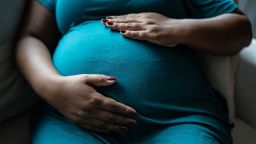As women continue to die due to pregnancy or childbirth each year in the United States, new federal data shows that the nation’s maternal death rate rose significantly yet again in 2021, with the rates among Black women more than twice as high as those of White women.
Experts said the United States’ ongoing maternal mortality crisis was compounded by Covid-19, which led to a “dramatic” increase in deaths.
The number of women who died of maternal causes in the United States rose to 1,205 in 2021, according to a report from the National Center for Health Statistics, released Thursday by the US Centers for Disease Control and Prevention. That’s a sharp increase from years earlier: 658 in 2018, 754 in 2019 and 861 in 2020.
That means the US maternal death rate for 2021 – the year for which the most recent data is available – was 32.9 deaths per 100,000 live births, compared with rates of 20.1 in 2019 and 23.8 in 2020.
The new report also notes significant racial disparities in the nation’s maternal death rate. In 2021, the rate for Black women was 69.9 deaths per 100,000 live births, which is 2.6 times the rate for White women, at 26.6 per 100,000.
The data showed that rates increased with the mother’s age. In 2021, the maternal death rate was 20.4 deaths per 100,000 live births for women under 25 and 31.3 for those 25 to 39, but it was 138.5 for those 40 and older. That means the rate for women 40 and older was 6.8 times higher than the rate for women under age 25, according to the report.
The maternal death rate in the United States has been steadily climbing over the past three decades, and these increases continued through the Covid-19 pandemic.
Questions remain about how the pandemic may have affected maternal mortality in the United States, according to Dr. Elizabeth Cherot, chief medical and health officer for the infant and maternal health nonprofit March of Dimes, who was not involved in the new report.
“What happened in 2020 and 2021 compared with 2019 is Covid,” Cherot said. “This is sort of my reflection on this time period, Covid-19 and pregnancy. Women were at increased risk for morbidity and mortality from Covid. And that actually has been well-proven in some studies, showing increased risks of death, but also being ventilated in the intensive care unit, preeclampsia and blood clots, all of those things increasing a risk of morbidity and mortality.”
The American College of Obstetricians and Gynecologists previously expressed “great concern” that the pandemic would worsen the US maternal mortality crisis, ACOG President Dr. Iffath Abbasi Hoskins said in a statement Thursday.
“Provisional data released in late 2022 in a U.S. Government Accountability Office report indicated that maternal death rates in 2021 had spiked—in large part due to COVID-19. Still, confirmation of a roughly 40% increase in preventable deaths compared to a year prior is stunning new,” Hoskins said.
“The new data from the NCHS also show a nearly 60% percent increase in maternal mortality rates in 2021 from 2019, just before the start of the pandemic. The COVID-19 pandemic had a dramatic and tragic effect on maternal death rates, but we cannot let that fact obscure that there was—and still is—already a maternal mortality crisis to compound.”
Health officials stress that people who are pregnant should get vaccinated against Covid-19 and that doing so offers protection for both the mother and the baby.
During the early days of the pandemic, in 2020, there was limited information about the vaccine’s risks and benefits during pregnancy, prompting some women to hold off on getting vaccinated. But now, there is mounting evidence of the importance of getting vaccinated for protection against serious illness and the risks of Covid-19 during pregnancy.
The Covid-19 pandemic also may have exacerbated existing racial disparities in the maternal death rate among Black women compared with White women, said Dr. Chasity Jennings-Nu?ez, a California-based site director with Ob Hospitalist Group and chair of the perinatal/gynecology department at Adventist Health-Glendale, who was not involved in the new report.
“In terms of maternal mortality, it continues to highlight those structural and systemic problems that we saw so clearly during the Covid-19 pandemic,” Jennings-Nu?ez said.
“So in terms of issues of racial health inequities, of structural racism and bias, of access to health care, all of those factors that we know have played a role in terms of maternal mortality in the past continue to play a role in maternal mortality,” she said. “Until we begin to address those issues, even without a pandemic, we’re going to continue to see numbers go in the wrong direction.”
‘This is a problem in our country’
Some policies have been introduced to tackle the United States’ maternal health crisis, including the Black Maternal “Momnibus” Act of 2021, a sweeping bipartisan package of bills that aim to provide pre- and post-natal support for Black mothers, including extending eligibility for certain benefits postpartum.
As part of the Momnibus, President Biden signed the bipartisan Protecting Moms Who Served Act in 2021, and other provisions have passed in the House.
In the United States, about 6.9 million women have little or no access to maternal health care, according to March of Dimes, which has been advocating in support of the Momnibus.
The US has the highest maternal death rate of any developed nation, according to the Commonwealth Fund and the latest data from the World Health Organization. While maternal death rates have been either stable or rising across the United States, they are declining in most countries.
“A high rate of cesarean sections, inadequate prenatal care, and elevated rates of chronic illnesses like obesity, diabetes, and heart disease may be factors contributing to the high U.S. maternal mortality rate. Many maternal deaths result from missed or delayed opportunities for treatment,” researchers from the Commonwealth Fund wrote in a report last year.
The ongoing rise in maternal deaths in the United States is “disappointing,” said Dr. Elizabeth Langen, a high-risk maternal-fetal medicine physician at the University of Michigan Health Von Voigtlander Women’s Hospital. She was not involved in the latest report but cares for people who have had serious complications during pregnancy or childbirth.
Get CNN Health's weekly newsletter
- Sign up here to get The Results Are In with Dr. Sanjay Gupta every Tuesday from the CNN Health team.
“Those of us who work in the maternity care space have known that this is a problem in our country for quite a long time. And each time the new statistics come out, we’re hopeful that some of the efforts that have been going on are going to shift the direction of this trend. It’s really disappointing to see that the trend is not going in the right direction but, at some level, is going in the worst direction and at a little bit of a faster rate,” Langen said.
“In the health care system, we need to accept ultimate responsibility for the women who die in our care,” she added. “But as a nation, we also need to accept some responsibility. We need to think about: How do we provide appropriate maternity care for people? How do we let people have time off of work to see their midwife or physician so that they get the care that they need? How do all of us make it possible to live a healthy life while you’re pregnant so that you have the opportunity to have the best possible outcome?”
Correction: This story has been updated to reflect that the NCHS report was released on Thursday.




